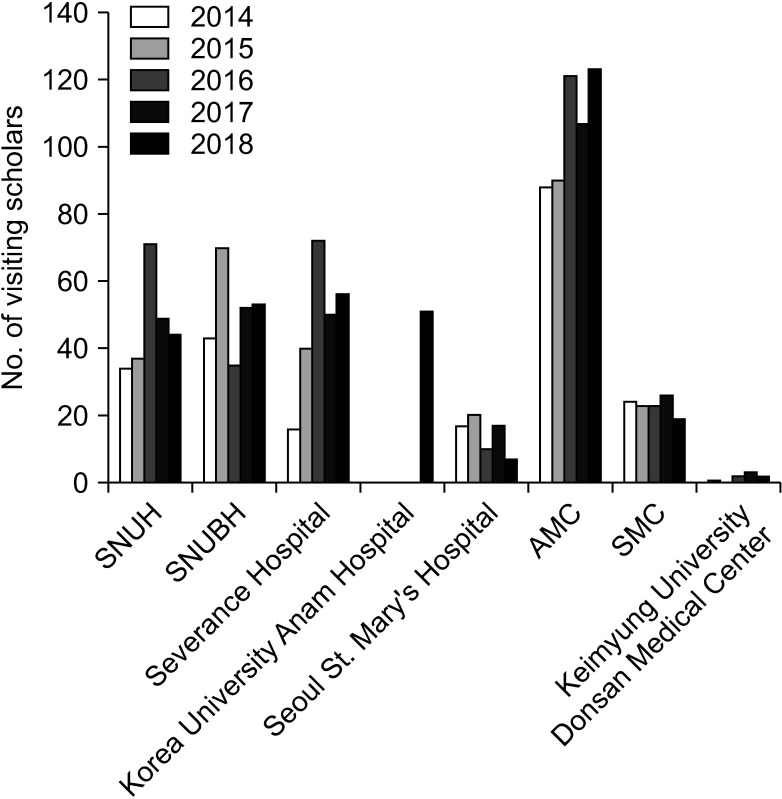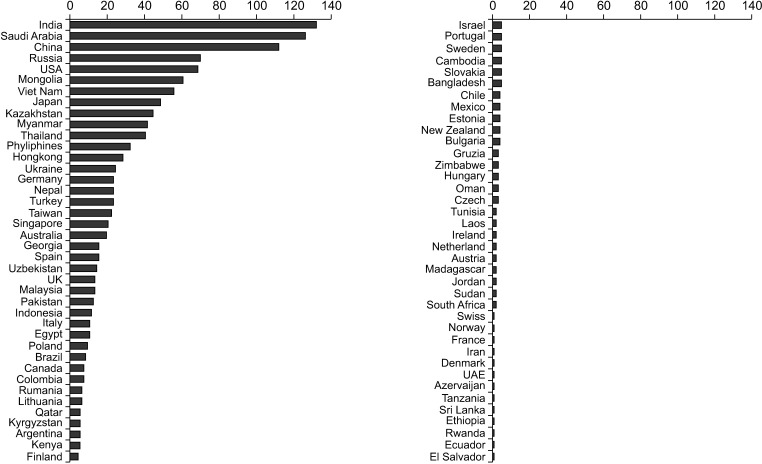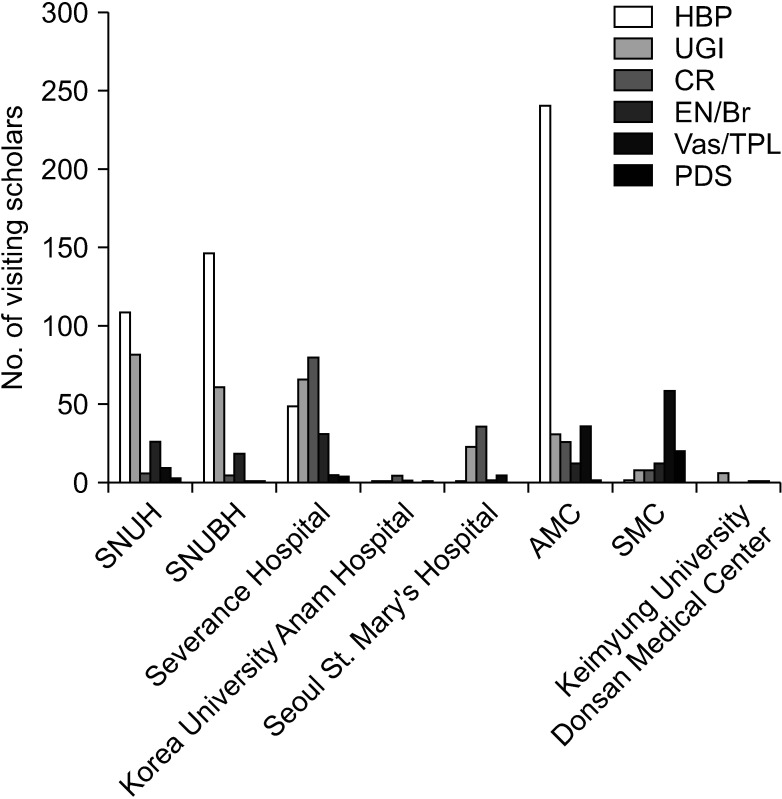Ann Surg Treat Res.
2020 Oct;99(4):189-196. 10.4174/astr.2020.99.4.189.
A survey investigating the current situation of the international visiting scholar program at the department of surgery in Korea
- Affiliations
-
- 1Department of Surgery, Seoul National University Hospital, Seoul National University College of Medicine, Seoul, Korea
- 2Department of General Surgery, Nottingham University Hospitals, North Trent Deanery, Health Education England, Nottingham, United Kingdom
- 3Department of Surgery, Korea University Anam Hospital, Korea University College of Medicine, Seoul, Korea
- 4Department of Surgery, Severance Hospital, Yonsei University College of Medicine, Seoul, Korea
- 5Department of Surgery, Asan Medical Center, Ulsan University College of Medicine, Seoul, Korea
- 6Department of Surgery, Seoul Metropolitan Government Seoul National University Boramae Medical Center, Seoul National University College of Medicine, Seoul, Korea
- 7Department of Surgery, Seoul St. Mary’s Hospital, College of Medicine, The Catholic University of Korea, Seoul, Korea
- 8Department of Surgery, Samsung Medical Center, Sungkyunkwan University College of Medicine, Seoul, Korea
- 9Department of Surgery, Seoul National University Bundang Hospital, Seoul National University College of Medicine, Seongnam, Korea
- 10Department of Surgery, Keimyung University Dongsan Medical Center, Keimyung University College of Medicine, Daegu, Korea
- 11Cancer Research Institute, Seoul National University, Seoul, Korea
- KMID: 2506649
- DOI: http://doi.org/10.4174/astr.2020.99.4.189
Abstract
- Purpose
The number of international visiting scholars has been on the increase in Korea and we aim to investigate the program’s current situation.
Methods
This cross-sectional study is based on an online survey questionnaire responded by international visiting scholars in surgical departments of 8 Korean hospitals between 2014 and 2018 about their experiences and satisfaction with the visiting scholar program.
Results
A total of 1,496 international scholars from 80 countries visited various surgical departments in 8 Korean hospitals between 2014 and 2018. The numbers have been on the increase over the years. Out of 355 visiting scholars in 2018, 71 replied to the online survey, of whom 52 were male and 19 female, and mostly in their 30s and 40s. Information about the program was accessed mostly through friends or colleagues (42.3%) and international conferences (36.6%). The commonest funding source was private (35.2%) and more than half stayed for less than 3 months. The visiting scholar’s main roles were mostly observation or participation in surgery and clinical research. All but 1 were satisfied with the program (98.6%) and would recommend it to friends and colleagues, although the language barrier was identified as an inconvenience. Those aged 20–39 years with governmental or institutional funding were associated with stays of more than 1 year.
Conclusion
The number of international visiting scholars at surgical departments in Korean hospitals has been on the increase with high satisfaction levels. Improvements need to be made on funding sources and lengthening visiting period to maximize the benefits of the program.
Keyword
Figure
Reference
-
1. Drain PK, Holmes KK, Skeff KM, Hall TL, Gardner P. Global health training and international clinical rotations during residency: current status, needs, and opportunities. Acad Med. 2009; 84:320–325. PMID: 19240438.2. Evensen A, Duffy S, Dawe R, Pike A, Nelson BD. Status of global health fellowship training in the United States and Canada. Can Med Educ J. 2019; 10:e80–e95. PMID: 31807229.3. Organisation for Economic Co-operation and Development (OECD). Cancer care: assuring quality to improve survival. Paris: OECD Publishing;;2013.4. Fan G, Zhou Z, Zhang H, Gu X, Gu G, Guan X, et al. Global scientific production of robotic surgery in medicine: a 20-year survey of research activities. Int J Surg. 2016; 30:126–131. PMID: 27154617.5. Lee Y. A study on the Jejungwon Hospital Building in Jaedong and Gurigae, and uses of the hospital after its relocation. Uisahak. 2016; 25:373–406. PMID: 28529299.6. Lee YA. A study on Horace N. Allen's medicine and recognition of Korean body. Uisahak. 2011; 20:291–325. PMID: 22343698.7. CEIC Data Korea Ltd. South Korea GDP per capita [Internet]. Seoul: CEIC;2020. cited 2020 Aug 24. Available from: https://www.ceicdata.com/en/indicator/korea/gdp-per-capita.8. Kim OJ, Hwang SI. The Minnesota Project: the influence of American medicine on the development of medical education and medical research in post-war Korea. Uisahak. 2000; 9:112–122. PMID: 12199222.9. Chun HM, Munyi EN, Lee H. South Korea as an emerging donor: challenges and changes on its entering OECD/DAC. J Int Dev. 2010; 22:788–802.10. Heimburger DC, Carothers CL, Gardner P, Primack A, Warner TL, Vermund SH. Nurturing the global workforce in clinical research: the National Institutes of Health Fogarty International Clinical Scholars and Fellows Program. Am J Trop Med Hyg. 2011; 85:971–978. PMID: 22144429.11. Kimball AM, Harper D, Creamer K, Adeyemi A, Yates R, Lillywhite L, et al. Strengthening public health leadership in Africa: an innovative fellowship program. Acad Med. 2019; 94:1146–1149. PMID: 30870155.12. Rezhake R, Hu SY, Zhao YQ, Zhang L, Zhao XL, Dominguez AZ, et al. Impact of international collaborative training programs on medical students' research ability. J Cancer Educ. 2018; 33:511–516. PMID: 27832507.13. Heimburger DC, Warner TL, Carothers CL, Blevins M, Thomas Y, Gardner P, et al. Recruiting post-doctoral fellows into global health research: selecting NIH Fogarty International Clinical Research Fellows. Am J Trop Med Hyg. 2014; 91:219–224. PMID: 24865678.14. Tankwanchi AB, Ozden C, Vermund SH. Physician emigration from sub-Saharan Africa to the United States: analysis of the 2011 AMA physician masterfile. PloS Med. 2013; 10:e1001513. PMID: 24068894.15. Silvestri DM, Blevins M, Afzal AR, Andrews B, Derbew M, Kaur S, et al. Medical and nursing students' intentions to work abroad or in rural areas: a cross-sectional survey in Asia and Africa. Bull World Health Organ. 2014; 92:750–759. PMID: 25378729.16. Vermund SH, Sahasrabuddhe VV, Khedkar S, Jia Y, Etherington C, Vergara A. Building global health through a center-without-walls: the Vanderbilt Institute for Global Health. Acad Med. 2008; 83:154–164. PMID: 18303361.17. Shin HY. Dr. LEE Jong-wook-Seoul Project - successful Korean version of Minnesota Project - could be a model of partner in the field of medicine. J Korean Med Sci. 2015; 30 Suppl 2:S113–S114. PMID: 26617442.18. The Korea Health Industry Development Institute (KHIDI). The Medical Korea Academy [Internet]. Cheongju: KHIDI;2020. cited 2020 Aug 24. Available from: https://www.khidi.or.kr/eps.19. Ministry of Health and Welfare. Limited permission for medical practice by international visiting medical doctors in Korea [Internet]. Seoul: Ministry of Health and Welfare;2019. cited 2020 Aug 24. Available from: http://www.mohw.go.kr/react/jb/sjb0406vw.jsp?PAR_MENU_ID=03&MENU_ID=030406&CONT_SEQ=351968.20. Ministry of Health and Welfare. Global cooperation [Internet]. Seoul: Ministry of Health and Welfare;c2020. cited 2020 Aug 24. Available from: http://www.mohw.go.kr/eng/pl/pl0104.jsp?PAR_MENU_ID=1003&MENU_ID=100327.21. Korean Surgical Society. 71st Annual Congress of Korean Surgical Society 2019 [Internet]. Seoul: Korean Surgical Society;2019. cited 2020 Aug 24. Available from: http://ackss.or.kr/2019_2/index.php.22. Korean Surgical Society. Korean Surgical Society International in Facebook [Internet]. Seoul: Korean Surgical Society;2020. cited 2020 Aug 24. Available from: https://www.facebook.com/groups/208162413671041.
- Full Text Links
- Actions
-
Cited
- CITED
-
- Close
- Share
- Similar articles
-
- Educational Outcomes and Perception Changes in Medical Students After Visiting a Blood Donation Center
- A Survey on the Situation of Integrative Lectures at Yonsei University, College of Medicine
- Development of the Model for Community-based Health Care Program for Premature Infants and Family
- The Effects of Visiting Exercise Program and Telecoaching for Physical Activity Promotion on Physical Fitness and Quality of Life in the Frail Elderly
- 2007 Survey for KSCRS Members: Current Trends in Refractive Surgery in Korea





